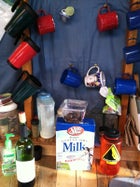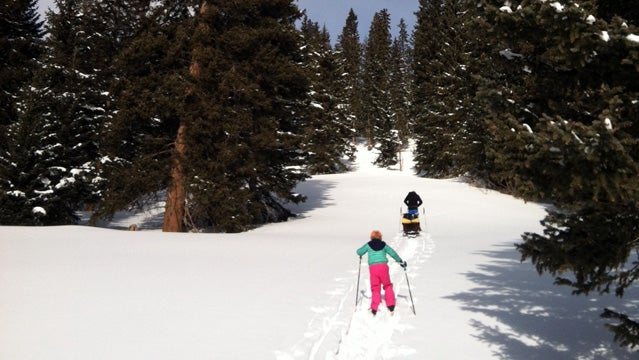After I posted my recent story about skiing into Spruce Hole, I realized it may have had the opposite effect of what I intended. Sure, the two-mile ski in was challenging, but it no way overshadowed the sheer bliss of escaping into the backcountry for two days. A little hardship always makes for a more interesting adventure, and we’d do it again in a second. That said, hut tripping with kids—winter or summer—never has to feel like a sufferfest if you follow a few common sense guidelines.
Raising Rippers
Katie Arnold and guests write regularly on family adventure and bringing up active children. When stocking the backcountry kitchen, bring only the essentials.
When stocking the backcountry kitchen, bring only the essentials.CHOOSE THE RIGHT HUT
One or two miles may sound kind of wimpy before you go, but when you’re lugging 60 pounds of kids or gear, even short approaches can feel burly. Generally speaking, less than three miles and relatively flat are best for hut trips with young ones who can’t ski in on their own. You’ll feel remote but will still be within easy range of your car if you need to pull the plug.
That said, our philosophy in the backcountry is to try to stick it out through tantrums or sleepless nights. The first 24 hours are usually the most challenging and by day two, everybody’s in a groove. If you do leave early, you’ll likely miss the best part. In New Mexico, the , and the , , and in Colorado, are all within a mile of the main road with minimal elevation gain.
ASK A LOT OF QUESTIONS
Is the hut or yurt in avalanche terrain? Does the route to the hut cross avalanche terrain? How is the hut heated? Don’t be afraid to come off as a nervous parent. Assessing safety and managing risks is your number one job when bringing kids into the backcountry. You’ll feel better if you know what you’re getting into. Of course, there will always be unknowns, but you can minimize risks if you do your homework, know your backup plans, and stay informed.
PACK SMART, PACK LIGHT
When kids are involved, it’s easy to fall into magical thinking and space on the most important truth of the whole trip: You will be hauling in every ounce you bring—both directions—and the weight of your load can set the tone for the whole trip. Be sure you need it, want it, absolutely must have it before you cram it in. For personal gear, you’ll need at least two sets of synthetic long underwear layers per person: one to wear while the other is drying in front of the wood stove.
Double up on mittens and hats, too.
Those get soggy fast while sledding and building snow caves. Don’t bother bringing PJs or apres-ski clothes—you’ll be living in your long underwear. Slippers are a nice touch while your ski boots dry, but check before you go: Spruce Hole has a stash, so we could have left ours at home. If the hut provides a packing checklist, use it. We got halfway through Spruce Hole’s list before we got distracted, and never finished. At the trailhead, Steve spent 10 minutes rooting around the truck for a lighter or a book of matches, but came up empty. Fortunately, we found about a hundred boxes waiting for us at the yurt when we got there.
You don’t have to go quite so extreme as dehydrated meals, but you’re better off taking a cue from backpackers, not river runners. Example: Leave the jar of peanut butter at home and opt for Ramen noodles instead. We brought a box of mac and cheese for the girls (light) but carelessly crammed in tupperware of leftover Thai noodles for us (bulky and big).
It’s nice to end the day with a beer or glass of wine, but if you’re the one schlepping it in, you might opt for a little flask of something instead. At the very least, bring beer in cans—you can crush them for the ski out. When it comes to keeping kids happy, packets of hot chocolate are worth their weight in gold, as are a few bags of M&Ms. Bribery goes a long way in the backcountry.
DIAL YOUR SYSTEM BEFORE YOU GO
Don’t wait until you get to the trailhead to set up your kids’ ski trailer or gear-carriers for the first time. I recently heard of a family that tried to rig theirs at the start of an overnight, only to discover that a key part of the kit was sold separately, and they hadn’t bought it. Game over. Take the trailers out for a trial run with the kids so they get a feel for what they’ll be riding in for a few hours. If they’re big enough to trek in under their own steam—lucky you—make sure you get them out on XC skis or snowshoes a few times before you go.
WAIT FOR A WEATHER WINDOW
Even if it’s a short distance and you’re familiar with the route, negotiating trails in a storm while fully loaded down is a stressful—and potentially dangerous—way to start the trip. We were supposed to ski in on a Sunday, but when we checked , a blizzard with whiteout conditions and negative windchill were forecast for the region all day.
Fortunately, our schedule was flexible, so we pushed the trip back by a day. And though we second-guessed our decision when we woke up on Sunday to blue skies, once we started skiing on Monday, I knew we’d made the right decision. It was arduous enough to pull all that weight without having to contend with frigid temperatures and low visibility, especially because our two-year-old, when left to her own devices, likes to take off her mittens and jacket. Not a good scene on super cold days. When checking forecasts, make sure you’re looking at the closest location at a similar altitude. A nearby town at lower elevations may have radically different weather than the mountain hut.
Finally, accept the fact it’s natural to feel anxious about traveling in the backcountry with kids, especially in winter. Don’t beat yourself up for worrying, or take worry as a sign you shouldn’t go. It comes with the territory. Do your homework, get your system dialed, and then you can relax knowing you’re well prepared. I might spend a week freaking out privately before the trip, but once we’re out there, the stress usually fades away, and I can be fully present with my family, playing outside. And that, of course, is the best reason to go.


